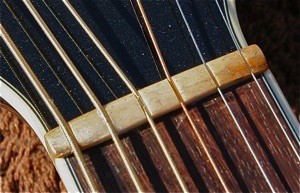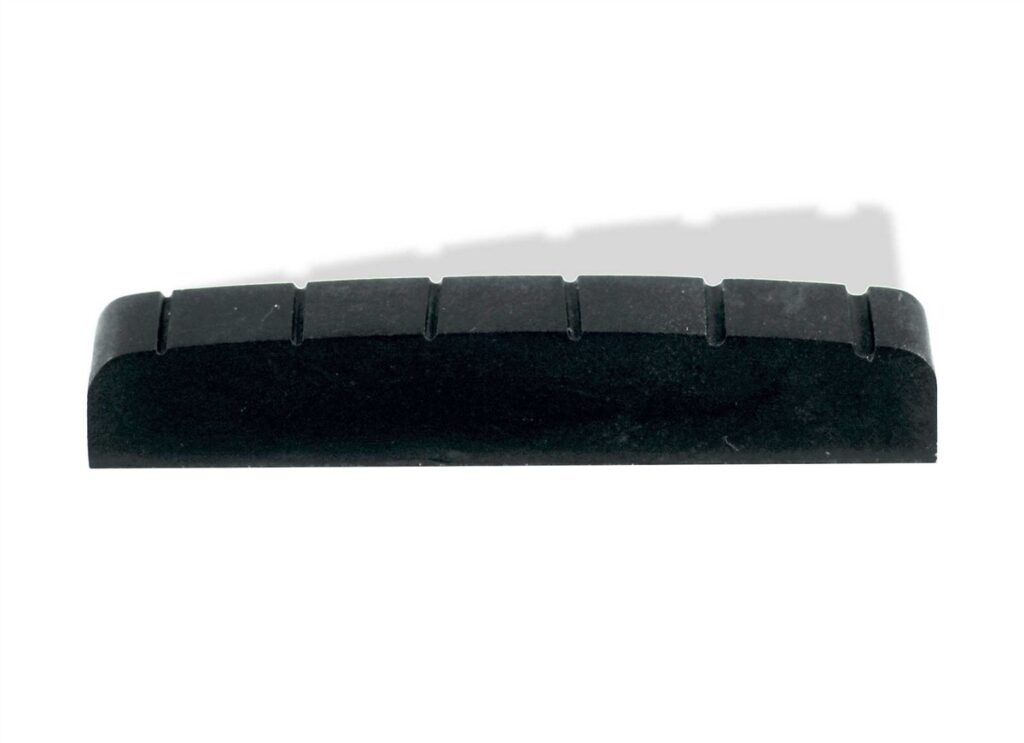Including the frets and bridge the Nut is the trinity of tone…
The guitar nut type can drastically impact your guitar tone! Being one of the smallest components on your guitar, this is usually underestimated!
Both material and fitting technique can affect the tone, sustain and performance (things like dead frets) of your guitar.
Guitar nut types? There are several guitar types each vary in design and material which include:
- Traditional Nut
- Lockin Nut
- Roller Nut
- Compensated Nut
- Bone Nut
- Fossil Ivory
- Plastic
- Metal
- Graphite
- Ebony
In this article, I will discuss ALL the pros and cons of each with some recommendations… Let’s get started!
What Is the Guitar Nut?
The nut rests at the end of your fretboard and is the last component that the strings come in contact with before reaching the headstock.
In short, it ensures the strings are at the right height above the fretboard (they help control the action at the top of the fretboard) and ensure the strings are evenly spaced.
Why is the Nut Essential?
The nut will impact the tone of your instruments open strings.
Both the density and cut will influence how well your guitar sustains and resonates of your open strings (the above video explains this in detail…).
1. “Bone” Material Type
I have spoken with many guitar luthiers and they all choose bone as their favourite material for a guitar nut. However, there are many considerations when choosing this particular material.
[amazon box=”B01EAF3HQE”]Pros
- Bone is mostly chosen because of its natural characteristics.
- Due to being very solid, dense and light, Bone, provides a desirable resonance and sustains very well when installed properly.
- In turn, Bone ensures remarkable strength against mechanical shocks and durability. Meaning it is relatively easy to work with and enables fine-tuning reliability.
- Overall, Bone is used on many high-end guitars in the market.
Cons
- Bones natural properties also provide a disadvantage.
- This is because the very nature of bone is that it is hollow.
- Even though it has the desired hardness, you may find some soft spots. If this is the case then you will find slightly different characteristics across the nut when you play.
- This can make it slightly more difficult to work with when trying to repeat identical tones across the strings and a mass production.
- I have also heard that bone can grab the strings causing friction across the strings. This can result in some tuning issues. This will require you to file it down smooth and sometime even lubricate it.
- It is also relatively expensive compared to plastic.
2. Fossil Ivory Material Type
Fossil ivory is a material that comes from elephants tusks. This is banned in many countries as this material is collected by poaches that hunt elephants.
Because of this reason, I do not recommend using this material. However, because it is used I will still discuss it properties.

Pros
- Fossil ivory is quite similar to bone, it resonates exceptionally well and sustains just as well as bone. However, it does provide a slightly different tone.
- It provides resonance and sustain in equal measure.
- This material is equally impressive as far as its acoustic properties and aesthetics. Due to it having slightly harder properties, it produces a brighter sound.
Cons
- Fossil ivory is slightly harder to work with than bone due to its hardness making it harder to craft and install on the headstock.
- NB/Non-fossil ivory is produced none ethically and banned in multiple countries.
3. Plastic Material Type
Different plastic materials including Corian and Micarta can be used to craft guitar nuts.
[amazon box=”B01IZ80KRG”]
Pros
- Using plastic can be very beneficial for a manufacturing perspective. It is cheap to produce and easy to craft with.
- Many low to mid end guitars come with plastic nuts due to their low-cost.
Cons
- Plastic lacks in terms of a performance due to its less solid properties.
- A good way to identify a high-end guitar is identifying the type of nut being used. Low-end guitars will tend to use plastic.
4. Metal Material Type
Brass and steel are two types of nut material that can be used for a guitar nut.
[amazon box=”B07MMTVTM9″]
Metal is an average sounding material in terms of the tonal properties. It is rated better than plastic but not as a good as bone or ivory.
Pros
- The main advantage of having a guitar nut that is made from brass or this material is durability. A steel or brass nut will last for a long time with minimum maintenance.
- A well cut brass nut is beautiful in its sound.
- Metal provides a very bright sound and suits country music as it provides a slight twang.
Cons
- Metal offers more high-end frequencies than the other materials and i do not find it as smooth and soft.
- Aesthetics do not really blend to well in my opinion unless you are using a steel guitar.
- These are the most difficult and expensive to use, and the tone is certainly not for everyone.
5. Graphite Material Type
Graphite is another material that is commonly used for nut construction.

Pros
- The major advantage to this material is that it is self-lubricating for low friction. Also, a good graphite nut offers impeccable tuning stability and a variety of tremolo effects.
- Benefits – slickness for improved tuning stability (presuming nut slotting is done well for your chosen string gauge).
- Especially useful with ‘bendy’ type playing (that’s certainly my finding, though I’m using TusqXL rather than graphite – see below).
- Graphite is useful if you do a lot of dive bombs on the whammy bar and don’t want to go for a locking nut.
Cons
- Cheap graphite nuts, however, tend to kill these advantages.
- Graphtec will be the most consistent. It has a smooth sound, and is relatively easy to work with.
- Downside – none, as long as you don’t mind the nut being black.
- If you prefer an ivory look, consider putting in Tusq / XL.
6. Ebony Material Type
Ebony is another material that is commonly used for guitar construction.

Pros
- Ebony has its main advantage down to its aesthetics and it looks appealing.
- It also has some good sound qualities as well. It is considered better than plastic as well as being consistent in sounding. .
Cons
- The disadvantage is using ebony is that it doesn’t quite resonate as well as bone or graphite as the tone tends soften much faster.
Conclusion:
The nut plays a vital role in producing the sound your guitar makes.
The difference in tone between bone, ivory and plastic is more evident on acoustic guitars, but can still be noticeable on electric guitar especially in the studio.
In addition, solid body electric guitars that are going to be used with heavy fuzz and distortion may also the subtle difference between the different types of nuts. Nevertheless, playing clean, or layering guitar these subtleties will stand out.
Bone is most preferred, this includes Tusq. Or “fossilized” walrus ivory or old recycled ivory. However, you can find inconsistent sounds in the bone material.
Furthermore, Using ivory from poached elephants is illegal due to its immorality. Unless, the animal died of natural causes such as “fossilized” walrus ivory.
Bone is relatively easy to cut and work on though. I do not hear too much of a tone difference between bone and graphite, I just know the graphite is easier and never grabs strings like a bone one can.
Overall, while bone is generally most preferable don’t be afraid to experiment with the other options. But, remember to avoid ivory as it comes from poached elephants.


Great content! Super high-quality! Keep it up! 🙂
Thanks so much!
Thanks! I found this very useful!
I am glad it helped you 🙂
Hi, excellent website you’ve got going here.
Thanks!
Great article! keep it up.
Thanks!
You left out TUSQ, which is my preferred material.
Hi Kamiel, thanks for your comment.
The reason i left out TUSQ as being one of the best, is that even though it sounds nice it is generally collected by hunters.
I also think graphite is a close and healthy alternative!
I have a 1967 Kent electric (looks like a SG) the nut on it was made from a Colgate plus toothbrush and I have to admit it sustains much longer than any of my top shelf axes that have bone nuts.
Hi Raymond, this is a brilliant story!
Thanks for sharing! I may have to consider extending my list 🙂